 | |
| Genre | Role-playing games |
|---|---|
| Publisher | TSR |
Publication date | 1996 |
| Media type | Boxed set |
Bleak House: The Death of Rudolph van Richten is an accessory for the 2nd edition of the Advanced Dungeons & Dragons fantasy role-playing game, published in 1996.
 | |
| Genre | Role-playing games |
|---|---|
| Publisher | TSR |
Publication date | 1996 |
| Media type | Boxed set |
Bleak House: The Death of Rudolph van Richten is an accessory for the 2nd edition of the Advanced Dungeons & Dragons fantasy role-playing game, published in 1996.
Bleak House: The Death of Rudolph van Richten is a campaign consisting of three adventures for the Ravenloft setting, consisting of "Adventure One, Whom Fortune Would Destroy", "Adventure Two, The Baron", and "Adventure Three, Homecoming". [1] In "Whom Fortune Would Destroy", the player characters are stranded on an isolated desert island and become the guests of a respected psychologist whose treatments at the Asylum seem to be effective while their effects are disturbing. [1] "The Baron" takes place in a city, where the characters pursue leads that they learned about in the madhouse to find out what is happening to Rudolph van Richten. [1] "Homecoming" takes the characters back to the Van Richten family estate Bleak House where they must solve a mystery quickly, try to stay sane, rescue Van Richten and escape. [1] "Homecoming" uses an invisible time-line to keep the action moving, and also employs the Tarokka (Tarot) system and the adventure has four possible endings. [1]
Bleak House: The Death of Rudolph van Richten was published by TSR, Inc. in 1996.
Trenton Webb reviewed Bleak House: The Death of Rudolph van Richten for Arcane magazine, rating it an 8 out of 10 overall. [1] He calls Bleak House "the rip-roaring finale of Ravenloft's most famous do-gooder" where "only the lucky will survive," stating that the adventure campaign "ranks as one of Ravenloft's best ever, bundling together classic horror tales, rewarding roleplaying and the resurrection of some fine game mechanics". [1]
He felt that Bleak House "has a distinct Star Wars feel," saying that "Whom Fortune Would Destroy" is "great" and that "The Baron" is "a necessary but unsatisfying transition" while "Homecoming" offers "the equivalent payoff of a second Death Star assault, Ewok battle, Duel with Darth Vader and then some." [1] Of "Whom Fortune Would Destroy" Webb notes that it "plays the madness card" calling it a "harrowing and invasive scenario" which "pushes close to the bounds of gaming good taste" in that it "doles out vicious mental torture with such wanton disregard for the consequences that less mature players will feel personally slighted and abused." [1] Of "The Baron," he calls it "the weakest of the three scenarios," but sees it as "probably a necessary evil, as veterans of the Asylum will need some time to get their characters' minds and bodies back together, but the change is too sudden." [1] Of "Homecoming" Webb says that it is there "that the horror side of Ravenloft really kicks in, and it's terrifyingly good", adding that as a stand-alone it "would be strong, but as the climax to a three-part scenario it's near perfect. Uniting the themes of the earlier scenarios and drawing on the full Van Richten legend. It hammers home the horror harder than nails in a coffin" and concludes that its "mix of mysteries and combat maintains the Ravenloft balance, while the use of Van Richten gives the whole affair an epic air. It's a tense and spectacular adventure." [1]
Webb commented that the whole Bleak House campaign "is a strong blend of the old and the new. Haunted houses and deserted islands are hardly original Ravenloft concepts, but they're delivered in a confident and coherent style." [1] He noted a few problems with Bleak House: "Van Richten, for instance, seems to have forgotten what he learned from Dr. Illhousen in the Nightmare Lands expansion. The impact of the shipwreck scenario is marred if you've played Neither Man Nor Beast and the manuals suffer from clumsy artwork. But those are points for pedants." [1] Webb concluded the review by saying, "Bleak House is a campaign that will destroy many characters and leave survivors staggering and scarred. Yet those who roam the Demi-Plane of Dread have asked for that, and they've opted to explore the nastier end of gaming and enjoy recreating famous moments of horror. Bleak House delivers this in spades. I just wish I'd never read it - because then I could play it!" [1]

Ravenloft is a campaign setting for the Dungeons & Dragons roleplaying game. It is an alternate time-space existence known as a pocket dimension or demiplane, called the Demiplane of Dread, which consists of a collection of land pieces called "domains", brought together by a mysterious force known only as the Dark Powers. Each domain is tailored to and mystically ruled by a being called a Darklord who is forever trapped and surrounded by magical mists surrounding the domain. Strahd von Zarovich, a vampire in the original AD&DRavenloft I6 module released in 1983, became the first Darklord, both ruler and prisoner of his own personal domain of Barovia. The story of how Count von Zarovich became Darklord of Barovia was detailed in the 1993 novel I, Strahd: The Memoirs of a Vampire. As originally established in the Ravenloft: Realm of Terror boxed set known as "the Black Box" released in 1990, the Ravenloft campaign setting was located in the Ethereal Plane. As a physical manifestation of that plane, lands, monsters and even people were created out of the mysterious mists, and the realm acted as a prison where one could enter or be transported, but means of escape were few. Other Ravenloft Domains and Darklords were eventually added in various AD&D 2nd edition products establishing a core continent attached around Barovia which could be traveled to by others if their respective lords allowed entering or leaving their borders; while some Domains remained isolated in the mists and were referred to as Islands.
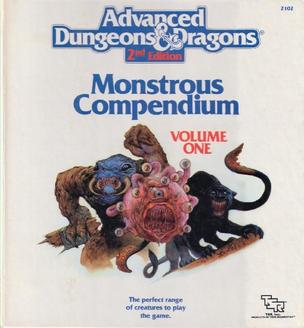
The Monstrous Compendium is a series of accessories for the Advanced Dungeons & Dragons fantasy role-playing game released from 1989 to 1998. The title was then used for a series of 5th Edition Dungeons & Dragons supplements released on D&D Beyond.

Ravenloft is an adventure module for the Dungeons & Dragons (D&D) fantasy role-playing game. The American game publishing company TSR, Inc. released it as a standalone adventure booklet in 1983 for use with the first edition Advanced Dungeons & Dragons game. It was written by Tracy and Laura Hickman, and includes art by Clyde Caldwell with maps by David Sutherland III. The plot of Ravenloft focuses on the villain Strahd von Zarovich, a vampire who pines for his lost love. Various story elements, including Strahd's motivation and the locations of magical weapons, are randomly determined by drawing cards. The player characters attempt to defeat Strahd and, if successful, the adventure ends.
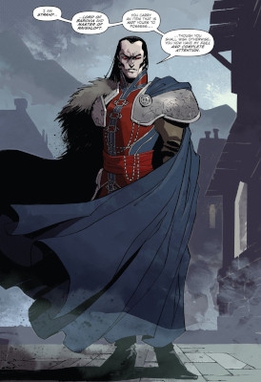
Count Strahd von Zarovich is a fictional character originally appearing as the feature villain in the highly popular Advanced Dungeons and Dragons adventure module I6: Ravenloft. Later, this character and his world would be explored in follow-up modules, novels, and the Ravenloft campaign setting. Within this setting, Strahd is the first and best-known of Ravenloft's darklords. He is a powerful ancient vampire. He is also a master necromancer, a skilled warrior, and the unquestioned ruler of the domain of Barovia.
Darklord is a title used to refer to the mystically imprisoned and cursed ruler of a domain in Ravenloft, a campaign setting in the Dungeons & Dragons role-playing game.
The Vistani are a nomadic ethnic group in the Dungeons & Dragons fantasy role-playing game. They are based on depictions of the Romani people, and over time this depiction has been criticized as overly stereotyped and pejorative, and subject to some revisions in the D&D canon.
In the Dungeons & Dragons fantasy role-playing game, a vampire is an undead creature. A humanoid or monstrous humanoid creature can become a vampire, and looks as it did in life, with pale skin, haunting red eyes, and a feral cast to its features. A new vampire is created when another vampire drains the life out of a living creature. Its depiction is related to those in the 1930s and 1940s Hollywood Dracula and monster movies. In writing vampires into the game, as with other creatures arising in folklore, the authors had to consider what elements arising in more recent popular culture should be incorporated into their description and characteristics.

I, Strahd: The Memoirs of a Vampire is a 1993 fantasy horror novel by P. N. Elrod, set in the world of Ravenloft, and based on the Dungeons & Dragons game. Its plot centers on the army commander Strahd Von Zarovich who takes up residence in Ravenloft and then, consumed by envy and regret for lost youth, succumbs to the temptations of the dark arts.

The Nightmare Lands is an accessory for the 2nd edition of the Advanced Dungeons & Dragons fantasy role-playing game, published in 1995.
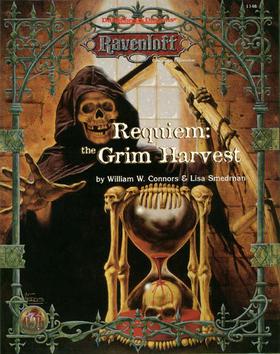
Requiem: The Grim Harvest is an accessory for the 2nd edition of the Advanced Dungeons & Dragons fantasy role-playing game, published in 1996.
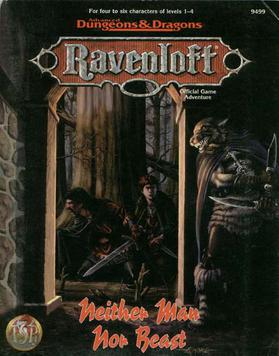
Neither Man nor Beast is an adventure for the 2nd edition of the Advanced Dungeons & Dragons fantasy role-playing game, published in 1995.
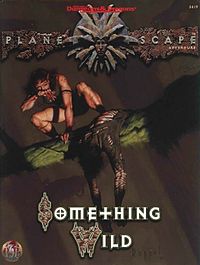
Something Wild is an adventure module for the 2nd edition of the Advanced Dungeons & Dragons fantasy role-playing game, published in 1996.
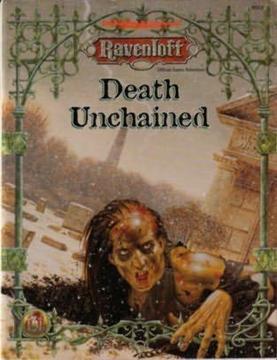
Death Unchained is an adventure for the 2nd edition of the Advanced Dungeons & Dragons fantasy role-playing game.

Death Ascendant is an adventure for the 2nd edition of the Advanced Dungeons & Dragons fantasy role-playing game.

The Return of Randal Morn is an adventure module for the 2nd edition of the Advanced Dungeons & Dragons fantasy role-playing game, published in 1996.

Doors to the Unknown is an accessory for the 2nd edition of the Advanced Dungeons & Dragons fantasy role-playing game.

Children of the Night: Vampires is an accessory for the 2nd edition of the Advanced Dungeons & Dragons fantasy role-playing game, published in 1996.
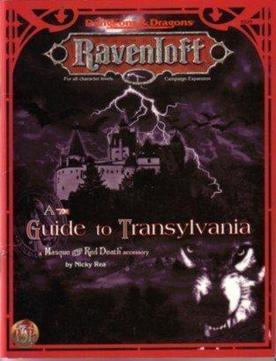
A Guide to Transylvania is an accessory for the 2nd edition of the Advanced Dungeons & Dragons fantasy role-playing game, published in 1996.

Van Richten's Guide to Ravenloft is a sourcebook that details the Domains of Dread from the Ravenloft campaign setting for the 5th edition of the Dungeons & Dragons fantasy role-playing game.